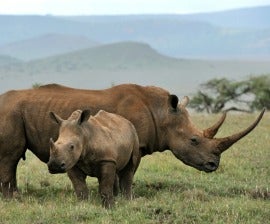-

When adults are poached, calves are left to starve. Christophe Cerisier/istock
Rhino horn is a highly valued commodity, used in Traditional Chinese Medicine in East Asian communities around the world.
Made of keratin, the same substance in human hair and nails, the horn has no proven medicinal value. However, it has been used for centuries as a treatment for various ailments, including headaches, fevers, rheumatism and gout.
Increased demand
A recent, unsubstantiated claim that a high-ranking Vietnamese government official was cured of cancer by using rhino horn has resulted in a massive increase in demand in Vietnam and China, and the price has skyrocketed. Prices as high as US $60,000 per kg for powdered horn have been reported, which makes rhino horn, kilo for kilo, more expensive than street cocaine in the UK. As a result, rhinos are being threatened across their range.
The last wild northern white rhinos, a subspecies distinct from the southern white rhino, disappeared a few years ago, and if the problem is not addressed, more species will undoubtedly follow.
Calves left to starve
Reports of rhinos being killed, their horns sawn off, and calves left to starve, are an almost daily occurrence. Some animals are sedated, and recover from the poachers’ butchery only to suffer a prolonged and painful death through blood loss and infection. Poachers and park rangers are often involved in shoot-outs, with fatalities on both sides. It’s nothing short of a war.
Enforcement
Authorities in range states have been stepping up their efforts to protect their rhinos. South African authorities have deployed the army to patrol parts of Kruger National Park where poaching is most rife. They have also arrested veterinarians, safari operators and other high-profile citizens in association with rhino poaching.
Information sharing within South Africa and between countries has also improved, and international enforcement bodies including Interpol and customs authorities have come together under the banner of the International Consortium to Combat Wildlife Crime, the Rhino Task Force, the Coalition Against Wildlife Trafficking (of which HSI is a member) and others.
However, with such large amounts of money at stake, heavily armed poachers financed by well-resourced criminal syndicates have been employing increasingly sophisticated technology to obtain the precious horn, including helicopters, night-vision equipment, and highly sophisticated veterinary drugs. Corruption in some parts of Africa and Asia is reportedly commonplace among enforcement and government officials. Faced with this, beleaguered authorities are struggling.
Antique trade
With rhino horn so valuable in the Traditional Chinese Medicine markets, the number of thefts of rhino horn exhibits from museums and private premises has increased dramatically in recent years. Between April 2008 and September 2011, at least 41 rhino horns, some dating back to the 19th century, were stolen from displays in Europe, South Africa and the United States.
European law enforcement agency Europol uncovered a European organised crime syndicate behind many of these thefts.
Auction houses
A rise in the number of antique rhino horn objects and trophies sold through auction houses has also raised concerns about the final destination of the items.
In 2010 alone, it is understood that six UK auction houses sold antique rhino horns for an accumulated value of USD $2,180,000.
In many cases, there was a significant discrepancy between the advertised guide price and the price eventually realized at auction. In one case, a rhino horn mounted on a shield that was expected to reach £20-30,000 was sold for £60,000. A carved 17th century libation cup expected to reach £30-50,000 sold for £280,000.
There are concerns that traders may be buying antiques and legally exporting them, only for them to be ground down and sold as powdered horn in the Far East.
In September 2010, the British government placed severe domestic restrictions on the re-export of antique rhino horn objects and trophies amid reports that high prices were being paid for such items at auctions. Germany introduced similar restrictions a month later and in February 2011, the EU enacted similar regulations.
The U.S. is also a major trader in antique rhino horn objects. HSI has documented the problem and requested [PDF] that the U.S. government urgently adopt stricter measures as the EU has done. HSI has also contacted [PDF] the major auction houses to ask that they voluntarily stop offering sales of rhino horn objects.
